Forging is a metal working process that involves applying pressure (ranging from hundreds to thousands of tons) to metal materials by heating them to an ideal processing temperature and using the pressure to shape the metal and fill the mold cavity, in order to obtain certain mechanical properties, shapes, and dimensions. In order to soften the material for easy processing, the raw material is often heated before forging during the process.
Forging can be divided into two types based on the temperature during processing: "hot/warm forging" and "cold forging". Hot forging involves applying pressure to the raw material at a temperature higher than the recrystallization temperature to remove the gases that are trapped in the material, creating a more dense crystallization and increasing the strength. Cold forging involves directly applying pressure to the raw material below the recrystallization temperature to shape it. Cold forging not only has high processing accuracy but also can increase the strength of the material. However, not all metals are suitable for cold forging. For example, metals with high carbon content, due to their poor ductility, are not suitable for cold forging, as it may cause them to become brittle and even fracture.


